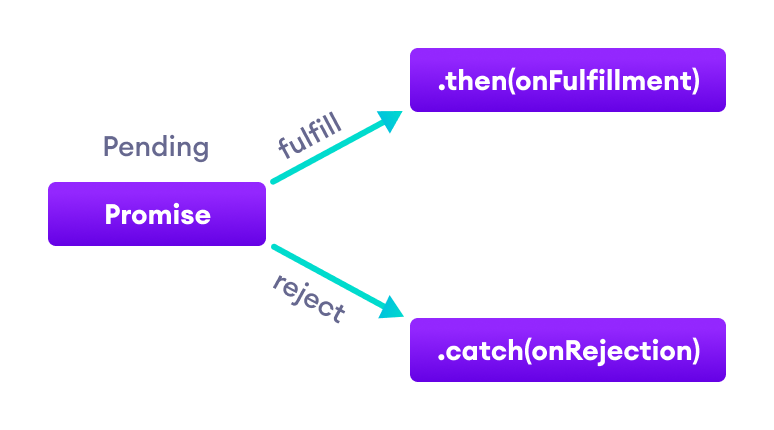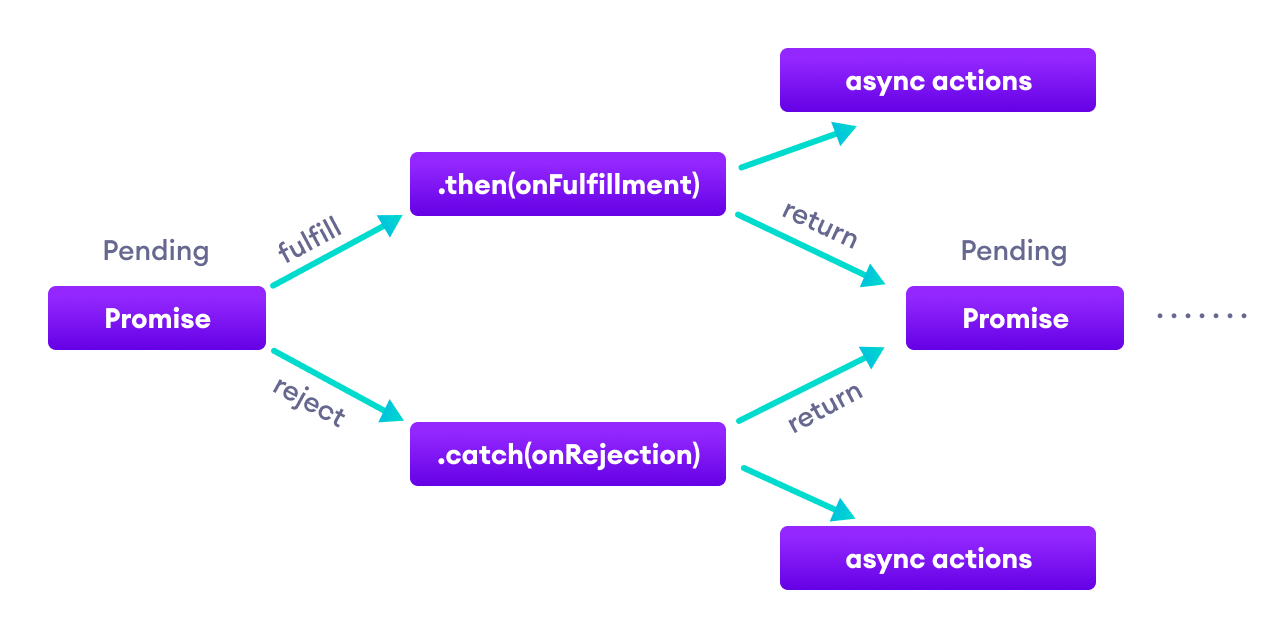In JavaScript, a promise is a good way to handle asynchronous operations. It is used to find out if the asynchronous operation is successfully completed or not.
A promise may have one of three states.
- Pending
- Fulfilled
- Rejected
A promise starts in a pending state. That means the process is not complete. If the operation is successful, the process ends in a fulfilled state. And, if an error occurs, the process ends in a rejected state.
For example, when you request data from the server by using a promise, it will be in a pending state. When the data arrives successfully, it will be in a fulfilled state. If an error occurs, then it will be in a rejected state.
Create a Promise
To create a promise object, we use the Promise() constructor.
let promise = new Promise(function(resolve, reject){
//do something
});
The Promise() constructor takes a function as an argument. The function also accepts two functions resolve() and reject().
If the promise returns successfully, the resolve() function is called. And, if an error occurs, the reject() function is called.
Let's suppose that the program below is an asynchronous program. Then the program can be handled by using a promise.
Example 1: Program with a Promise
const count = true;
let countValue = new Promise(function (resolve, reject) {
if (count) {
resolve("There is a count value.");
} else {
reject("There is no count value");
}
});
console.log(countValue);
Output
Promise {<resolved>: "There is a count value."}
In the above program, a Promise object is created that takes two functions: resolve() and reject(). resolve() is used if the process is successful and reject() is used when an error occurs in the promise.
The promise is resolved if the value of count is true.

JavaScript Promise Chaining
Promises are useful when you have to handle more than one asynchronous task, one after another. For that, we use promise chaining.
You can perform an operation after a promise is resolved using methods then(), catch() and finally().
JavaScript then() method
The then() method is used with the callback when the promise is successfully fulfilled or resolved.
The syntax of then() method is:
promiseObject.then(onFulfilled, onRejected);
Example 2: Chaining the Promise with then()
// returns a promise
let countValue = new Promise(function (resolve, reject) {
resolve("Promise resolved");
});
// executes when promise is resolved successfully
countValue
.then(function successValue(result) {
console.log(result);
})
.then(function successValue1() {
console.log("You can call multiple functions this way.");
});
Output
Promise resolved You can call multiple functions this way.
In the above program, the then() method is used to chain the functions to the promise. The then() method is called when the promise is resolved successfully.
You can chain multiple then() methods with the promise.
JavaScript catch() method
The catch() method is used with the callback when the promise is rejected or if an error occurs. For example,
// returns a promise
let countValue = new Promise(function (resolve, reject) {
reject('Promise rejected');
});
// executes when promise is resolved successfully
countValue.then(
function successValue(result) {
console.log(result);
},
)
// executes if there is an error
.catch(
function errorValue(result) {
console.log(result);
}
);
Output
Promise rejected
In the above program, the promise is rejected. And the catch() method is used with a promise to handle the error.

JavaScript Promise Versus Callback
Promises are similar to callback functions in a sense that they both can be used to handle asynchronous tasks.
JavaScript callback functions can also be used to perform synchronous tasks.
Their differences can be summarized in the following points:
JavaScript Promise
- The syntax is user-friendly and easy to read.
- Error handling is easier to manage.
- Example:
api().then(function(result) { return api2() ; }).then(function(result2) { return api3(); }).then(function(result3) { // do work }).catch(function(error) { //handle any error that may occur before this point });
JavaScript Callback
- The syntax is difficult to understand.
- Error handling may be hard to manage.
- Example:
api(function(result){ api2(function(result2){ api3(function(result3){ // do work if(error) { // do something } else { // do something } }); }); });
JavaScript finally() method
You can also use the finally() method with promises. The finally() method gets executed when the promise is either resolved successfully or rejected. For example,
// returns a promise
let countValue = new Promise(function (resolve, reject) {
// could be resolved or rejected
resolve('Promise resolved');
});
// add other blocks of code
countValue.finally(
function greet() {
console.log('This code is executed.');
}
);
Output
This code is executed.
JavaScript Promise Methods
There are various methods available to the Promise object.
| Method | Description |
|---|---|
all(iterable) |
Waits for all promises to be resolved or any one to be rejected |
allSettled(iterable) |
Waits until all promises are either resolved or rejected |
any(iterable) |
Returns the promise value as soon as any one of the promises is fulfilled |
race(iterable) |
Wait until any of the promises is resolved or rejected |
reject(reason) |
Returns a new Promise object that is rejected for the given reason |
resolve(value) |
Returns a new Promise object that is resolved with the given value |
catch() |
Appends the rejection handler callback |
then() |
Appends the resolved handler callback |
finally() |
Appends a handler to the promise |
To learn more about promises in detail, visit JavaScript Promises.